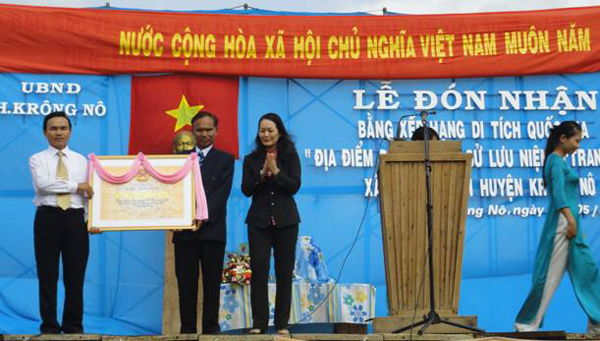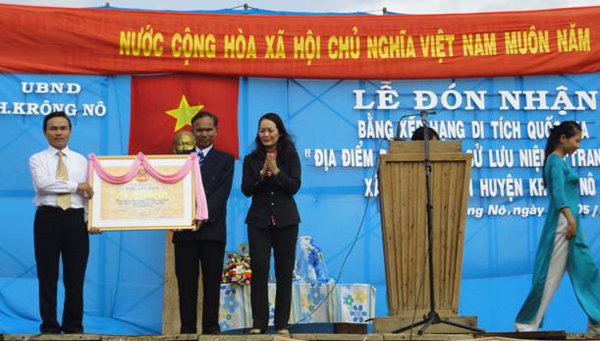
N'Trang Guh memorial place - the historical monument in Choah village (Krong No district) was recognized as the national historical monument by the Ministry of Culture, Sports and Tourism in Decision no. 2366/QD-BVHTTDL dated on August 02 2011.
 |
N' Trang Guh, whose real name is Y Guh H Dok, is from EDe ethnic group, he was born in 1845 at Choah Kplang village which belongs to the EDe Bih group living near the basin of Krong No river. He and the local residents stood up to resist bravely during 14 years (From 1900 to 1914), it was one of the biggest resistances in Central Highlands at that time.
In 1884, the Siamese troops waged an aggressive war, captured Krong No and Krong Ana lower rivers. Responding to the call of N'Trang Guh, people from 20 Bih ethnic villages stood up against foreign aggression. Insurgent army commanded by N'Trang Guh was up to 600 people without guns, they only used primitive weapons such as bows and arrows, spears, etc. In order to increase their strength, N'Trang Guh created a pretty special crossbow that was unprecedented. The crossbow had the length over the human head, its width was one span, and fired 3 arrows each time. With such powerful weapon and the brave, unyielding and ingenious spirit, in 1887, N'Trang Guh insurgent army surrounded and decimated the entire Siamese troops right on the fields of Tur village and Phok village (a village of Ede ethnic, located in Krong Ana lower rivers). The glorious victory of N'Trang Guh insurgent army crushed the Siamese invasion, helping the people to work securely and to construct their villages.
In the early years of the twentieth century, ruling apparatus of the French colonial government took over and controlled almost the villages of local residents in the Central Highlands. Bourgeois, the first French ambassador in Dak Lak had blatantly used military force to expel Ede, M'nong people to other places, took over villages, land, fields, and water stations to establish plantations and to build a military post system. The plantations' scale was more and more expanded, the regime of conscription for coolies work to Ede and M'nong people in the villages was more aggressive and violent. The draconian and brutal domination policy of the colonial made the local people fall into the extreme poverty and misery; so their indignation reached a high degree.
In the early of 1900, French troops occupied the villages of Bih along Krong No and Krong Ana lower rivers. N'Trang Guh led insurgent army to fight against the invaders, and the best well-known battle was the Tur military post decimation battle. In one morning of 1901, under the direction of N'Trang Guh, the insurgent army crossed Krong No river, surrounded Tur military post, used crossbows to shoot a lot of invaders and made an attack on the military post. Only in a short time, the entire enemy troops here were destroyed. The colonial Bourgeois who had many blood debts with the people died down in front of the post. To take advantage of the victory, the insurgent army continued to attack and destroy one after another military posts of colonial such as Jiang post, Dur post, etc (Jiang village of Ea Bong commune, Dur village of DurKman commune, Krong Ana, Dak Lak province now).
From 1901 to 1913, French troops repeatedly opened many military operations with pretty large scale in order to destroy and conquer the movement. But with the skillful and brave leadership of N'Trang Guh, the insurgent army had been fighting during 13 years. In 1914, as the insurgent army had betrayers, the stationing location of N'Trang Guh was disclosed, so he was arrested and sentenced to death by the French colonial.
After N'Trang Guh's death, his corpse was taken back and buried in his homeland, Choah village (nowadays it belongs to hamlet 1, Choah commune, Krong No district).
To mark the glorious victories of the village chief of the EDe people; N'Trang Guh, a hero of the Central Highlands ethnic minorities in the resistances against the foreign invasders. N'Trang Guh memorial place - the historical relics in Choah village (Krong No district) was recognized as the national historical monument by the Ministry of Culture, Sports and Tourism in Decision no. 2366/QD-BVHTTDL on August 02 2011